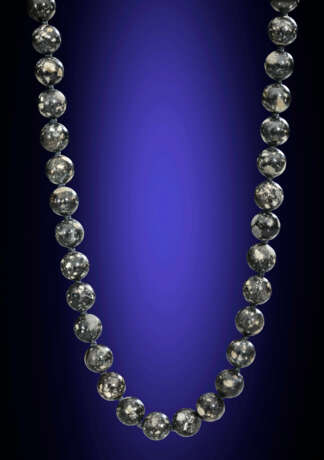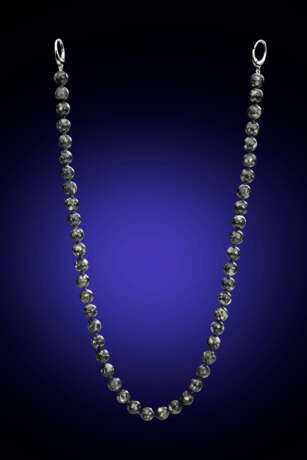ID 926998
Lot 1 | NWA 12691 — THE LUNAR NECKLACE
Valeur estimée
$ 140 000 – 200 000
The Moon is among the rarest substances on our planet. Less than 1400 kg of the Moon is known to exist on Earth and every single bit could fit in the trunk of a large SUV. While Apollo astronauts returned with approximately 382 kg of Moon rocks, not one milligram of this material is available for private ownership. As for the nearly 1000 kg of lunar meteorites, i.e., pieces of the Moon ejected off the lunar surface following an asteroid impact (nearly all of the craters on the Moon are the result of such impacts), a good deal of that material is also untouchable as a result of its residency in the world’s great museums and research institutions.
Scientists identify Moon rocks by specific textural, mineralogical, chemical, and isotopic signatures. Many of the common minerals found on Earth’s surface are rare or absent on the Moon and some lunar minerals are unknown on Earth. In addition, Moon rocks contain gases captured from the solar wind with isotope ratios very different from the same gases found on Earth.
As one would expect, many of the Moon rocks returned by Apollo missions are nearly identical to lunar meteorites — and such is the case with NWA 12691.
The protocol for a meteorite to be published in the Meteoritical Bulletin, the scientific journal of record, commences with the analysis of a specimen undergoing peer review by scientists on the Nomenclature Committee of the Meteoritical Society. As there needs to be a system to identify specimens, the Committee then chooses a name for the location to which it was “delivered,” (e.g., a city, village, mountain, river, district, etc.). In a desert, where there are few distinguishing landmarks, meteorites are named for the designated region where found, combined with sequential numbering. Found in 2017 by desert nomads, NWA 12691 is the 12,691st meteorite to be recovered from the North West African corridor of the Sahara Desert, analyzed and approved for publication.
NWA 12691 was part of an ancient strewn field of a large lunar meteorite shower straddling the Mauritanian, Western Saharan and Algerian borders — an event sufficiently large that it was responsible for a significant fraction of all lunar meteorites known.
From a curatorial standpoint, it’s only because of the relatively large amount of material recovered in this megafind that the opportunity to fashion a limited number of spheroidal specimens exists, as the trimming, grinding and polishing regimens result in a great deal of material loss. To create a sphere, one starts with preparing a square sample. Then each of the eight corners are cut to result in a 26-sided polyhedron. It is from each of these cut corners that the smaller lunar beads now offered were fabricated. In fact, several of the beads to make this necklace are from the same Moon rock as lot 44.
Each of the 48 beads is a pristine sample of the Moon; each bead measures approximately 8.25 millimeters in diameter and weighs approximately 3.66 carats. The beads were painstakingly fashioned by artisan Martin Roberts. Roberts is a master sphere fabricator and protégé of Dr. Robert Ritchie, who authored the standard source “The Sphere Maker’s Craft”. Fastened with a white gold clasp and knotted when strung, each of these lunar beads are of the highest quality. As is the case with any other lunar feldspathic breccia, each bead is composed of fragments of olivine, pigeonite, augite, ilmenite and signature white anorthite — which is rare on Earth but common on the Moon. The different minerals and lithologies were naturally bound together by a melt of lunar regolith, the result of repeated impacts on the lunar surface prior to the collision responsible for launching NWA 12691 to Earth.
If you truly love her to the Moon and back, you should have something to show for the journey — and this is likely the first necklace made of the Moon, one of the rarest substances on Earth.
The official classification of the material from which these beads were hewn was performed by Dr. Anthony Irving, the world’s foremost classifier of lunar and Martian meteorites. His work underwent peer review prior to publication in the 108th edition of the Meteoritical Bulletin.
Christie's would like to thank Dr. Alan E. Rubin at the Department of Earth, Planetary, and Space Sciences, University of California, Los Angeles for his assistance in preparing this catalogue.
18 inches long necklace. Each of the 48 beads measures approximately 8.25mm in diameter and weighs 3.66 carats.
| Style artistique: | Esthétisme |
|---|---|
| Catégorie: | Météorite |
| Style artistique: | Esthétisme |
|---|---|
| Catégorie: | Météorite |
| Adresse de l'enchère |
CHRISTIE'S 20 Rockefeller Plaza 10020 New York Etats-Unis | ||||||||||||||
|---|---|---|---|---|---|---|---|---|---|---|---|---|---|---|---|
| Aperçu |
| ||||||||||||||
| Téléphone | +1 212 636 2000 | ||||||||||||||
| Fax | +1 212 636 4930 | ||||||||||||||
| Conditions d'utilisation | Conditions d'utilisation | ||||||||||||||
| transport |
Service postal Service de messagerie ramassage par vous-même | ||||||||||||||
| Modes de paiement |
Virement bancaire | ||||||||||||||
| Heures d'ouverture | Heures d'ouverture
|




